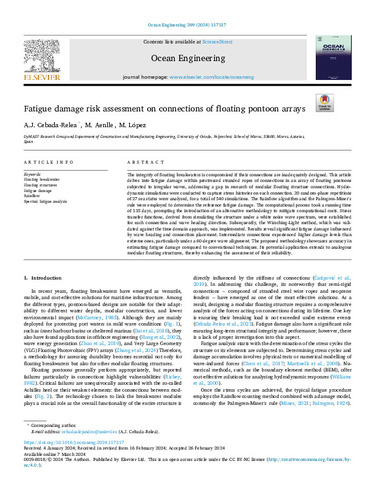Fatigue damage risk assessment on connections of floating pontoon arrays
Autor(es) y otros:
Fecha de publicación:
Versión del editor:
Citación:
Resumen:
The integrity of floating breakwaters is compromised if their connections are inadequately designed. This article delves into fatigue damage within prestressed stranded ropes of connections in an array of floating pontoons subjected to irregular waves, addressing a gap in research of modular floating structure connections. Hydrodynamic simulations were conducted to capture stress histories on each connection. 20 random-phase repetitions of 27 sea states were analysed, for a total of 540 simulations. The Rainflow algorithm and the Palmgren-Miner’s rule were employed to determine the reference fatigue damage. The computational process took a running time of 135 days, prompting the introduction of an alternative methodology to mitigate computational costs. Stress transfer functions, derived from simulating the structure under a white noise wave spectrum, were established for each connection and wave heading direction. Subsequently, the Wirsching-Light method, which was validated against the time domain approach, was implemented. Results reveal significant fatigue damage influenced by wave heading and connection placement. Intermediate connections experienced higher damage levels than extreme ones, particularly under a 60-degree wave alignment. The proposed methodology showcases accuracy in estimating fatigue damage compared to conventional techniques. Its potential application extends to analogous modular floating structures, thereby enhancing the assessment of their reliability.
The integrity of floating breakwaters is compromised if their connections are inadequately designed. This article delves into fatigue damage within prestressed stranded ropes of connections in an array of floating pontoons subjected to irregular waves, addressing a gap in research of modular floating structure connections. Hydrodynamic simulations were conducted to capture stress histories on each connection. 20 random-phase repetitions of 27 sea states were analysed, for a total of 540 simulations. The Rainflow algorithm and the Palmgren-Miner’s rule were employed to determine the reference fatigue damage. The computational process took a running time of 135 days, prompting the introduction of an alternative methodology to mitigate computational costs. Stress transfer functions, derived from simulating the structure under a white noise wave spectrum, were established for each connection and wave heading direction. Subsequently, the Wirsching-Light method, which was validated against the time domain approach, was implemented. Results reveal significant fatigue damage influenced by wave heading and connection placement. Intermediate connections experienced higher damage levels than extreme ones, particularly under a 60-degree wave alignment. The proposed methodology showcases accuracy in estimating fatigue damage compared to conventional techniques. Its potential application extends to analogous modular floating structures, thereby enhancing the assessment of their reliability.
ISSN:
Notas Locales:
OA ATUO24
Patrocinado por:
A. Cebada was supported by the “Ayudas para realizacion ´ de Tesis Doctorales. Modalidad A: Contratos de Investigacion ´ en r´egimen de concurrencia competitiva”, a research fellowship programme financed by the University of Oviedo (Spain) [grant number PAPI-22-PF-9]. The authors also would like to express their gratitude to the Spanish Ministry of Science and Innovation for the financial support through the project MCI-20-PID2019-105593 GB-00/AEI/10.13039/501100011033.
Colecciones
- Artículos [37550]
- Construcción e Ingeniería de Fabricación [508]
- Investigaciones y Documentos OpenAIRE [8421]
Ficheros en el ítem





